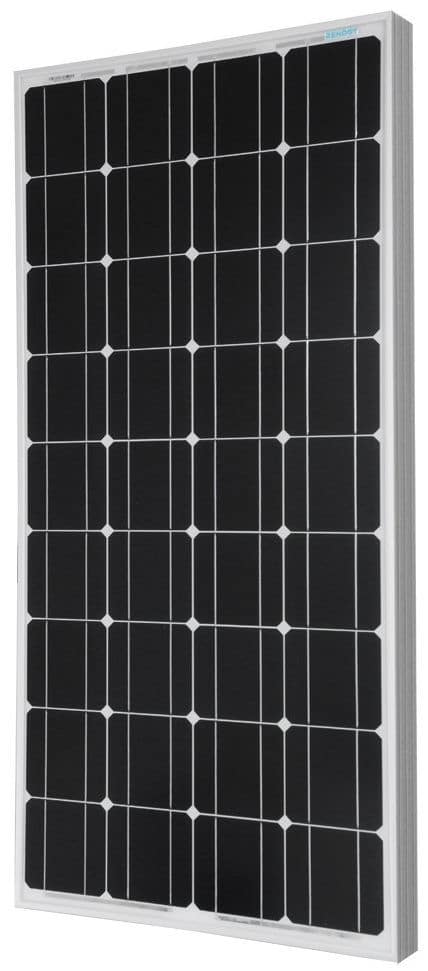
Connecting Solar Panels Together
How to Connect Solar Panels Together
![]() Connecting solar panels together is a simple and effective way of increasing your solar power capabilities. Going green is a great idea, and as the sun is our ultimate power source, it makes sense to utilize this energy to power our homes. As solar power becomes more accessible, more and more homeowners are buying photovoltaic solar panels.
Connecting solar panels together is a simple and effective way of increasing your solar power capabilities. Going green is a great idea, and as the sun is our ultimate power source, it makes sense to utilize this energy to power our homes. As solar power becomes more accessible, more and more homeowners are buying photovoltaic solar panels.
However, these photovoltaic solar panels can be very costly so buying them over time helps to spread the cost. But the problem then becomes how do we connect these extra solar panels together to increase the voltage and power output of what’s already there.
The trick here when connecting solar panels together is to choose a connection method that is going to give you the most energy efficient configuration for your particular requirements.
Connecting solar panels together can seem like a daunting task when you first start to look at how it should be done, but connecting multiple solar panels together is not that hard with a little thought. Wiring solar panels together in either parallel or series combinations to make larger arrays is an often overlooked, yet completely essential part of any well designed solar power system.
There are three basic but very different ways of connecting solar panels together and each connection method is designed for a specific purpose. For example, to produce more output voltage or to produce more current.
Solar photovoltaic panels can be electrically connected together in series to increase the voltage output, or they can be connected together in parallel to increase the output amperage. Solar pv panels can also be wired together in both series and parallel combinations to increase both the output voltage and current to produce a higher wattage array.
Whether you are connecting two or more solar panels, as long as you understand the basic principles of how connecting multiple solar panels together increases power and how each of these wiring methods works, you can easily decide on how to wire your own panels together. After all connecting solar panels together correctly can greatly improve the efficiency of your solar system.
Connecting Solar Panels Together in Series
The first method we will look at for connecting solar panels together is what’s known as “Series Wiring“. The electrical connection of solar panels in series increases the total system output voltage. Series connected solar panels are generally used when you have a grid connected inverter or charge controller that requires 24 volts or more. To series wire the panels together you connect the positive terminal to the negative terminal of each panel until you are left with a single positive and negative connection.
Solar panels in series add up or sum the voltages produced by each individual panel, giving the total output voltage of the array as shown.
Solar Panels in Series of Same Characteristics
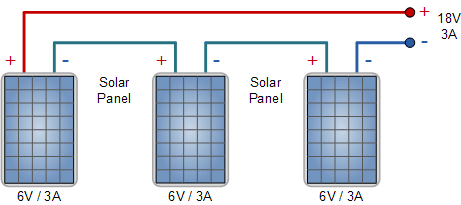
In this method ALL the solar panels are of the same type and power rating. The total voltage output becomes the sum of the voltage output of each panel. Using the same three 6 volt, 3.0 amp panels from above, we can see that when these pv panels are connected together in series, the array will produce an output voltage of 18 Volts (6 + 6 + 6) at 3.0 Amperes, giving 54 Watts (volts x amps) at full sun.
Now lets look at connecting solar panels in series with different nominal voltages but with identical current ratings.
Solar Panels in Series of Different Voltages
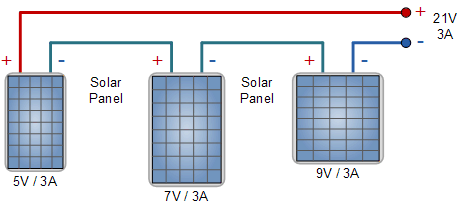
In this method all the solar panels are of different types and power rating but have a common current rating. When they are connected together in series, the array produces 21 volts at 3.0 amps, or 63 watts. Again the output amperage will remain the same as before at 3.0 amps but the voltage output jumps to 21 volts (5 + 7 + 9) .
Finally, lets look at connecting solar panels in series with completely different nominal voltages and different current ratings.
Solar Panels in Series of Different Currents
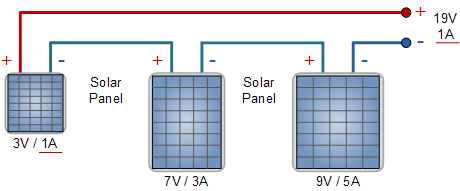
In this method all the solar panels are of different types and power rating. The individual panel voltages will add together as before, but this time the amperage will be limited to the value of the lowest panel in the series string, in this case 1 Ampere. Then the array will produce 19 Volts (3 + 7 + 9) at 1.0 Ampere only, or only 19 watts out of a possible 69 watts available reducing the arrays efficiency.
We can see that the solar panel rated at 9 volts, 5 amps, will only use one fifth or 20% of its maximum current potential reducing its efficiency and wasting money on the purchase of this solar panel. Connecting solar panels in series with different current ratings should only be used provisionally, as the solar panel with the lowest rated current determines the current output of the whole array.
Connecting Solar Panels Together in Parallel
The next method we will look at of connecting solar panels together is what’s known as “Parallel Wiring“. Connecting solar panels together in parallel is used to boost the total system current and is the reverse of the series connection. For parallel connected solar panels you connect all the positive terminals together (positive to positive) and all of the negative terminals together (negative to negative) until you are left with a single positive and negative connection to attach to your regulator and batteries.
When you connect solar panels together in parallel, the total voltage output remains the same as it would for a single panel, but the output current becomes the sum of the output of each panel as shown.
Solar Panels in Parallel of Same Characteristics
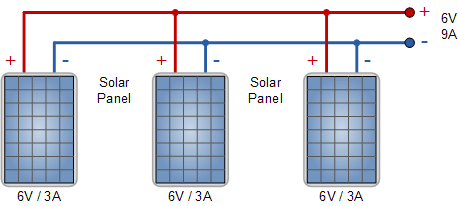
In this method ALL the solar panels are of the same type and power rating. Using the same three 6 Volt, 3.0 Amp panels as above, the total output of the panels, when connected together in parallel, the output voltage still remains at the same value of 6 volts, but the total amperage has now increased to 9.0 Amperes (3 + 3 + 3), producing 54 watts at full sun.
But what if our newly acquired solar panels are non-identical, how will this affect the other panels. We have seen that the currents add together, so no real problem there, just as long as the panel voltages are the same and the output voltage remains constant. Lets look at connecting solar panels in parallel with different nominal voltages and different current ratings.
Solar Panels in Parallel with Different Voltages and Currents
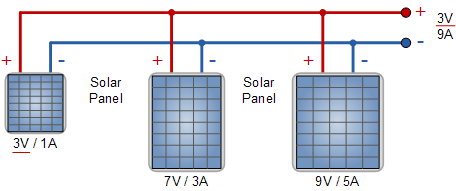
Here the parallel currents add up as before but the voltage adjusts to the lowest value, in this case 3 volts or some voltage value very close to 3 volts. Solar panels must have the same output voltage to be useful in parallel. If one panel has a higher voltage it will supply the load current to the degree that its output voltage drops to that of the lower voltage panel.
We can see that the solar panel rated at 9 volts, 5 amps, will only operate at a maximum voltage of 3 volts as its operation is being influenced by the smaller panel, reducing its efficiency and wasting money on the purchase of this higher power solar panel. Connecting solar panels in parallel with different voltage ratings is not recommended as the solar panel with the lowest rated voltage determines the voltage output of the whole array.
Then when connecting solar panels together in parallel it is important that they ALL have the same nominal voltage value, but it is not necessary that they have the same ampere value.
Connecting Solar Panels Together Summary
Connecting solar panels together to form bigger arrays is not all that complicated. How many series or parallel strings of panels you make up per array depends on what amount of voltage and current you are aiming for. If you are designing a 12 volt battery charging system than parallel wiring is perfect. If you are looking at a higher voltage grid connected system, than you’re probably going to want to go with a series or series-parallel combination depending on the number of solar panels you have.
But for a simple reference in regards to how to connect solar panels together in either parallel or series wiring configurations, just remember that parallel wiring = more amperes, and series wiring = more voltage, and with the right type and combination of solar panels you can power just about any electrical device you may have in your home.
For more information about Connecting Solar Panels Together in either series or parallel combinations, or to obtain more information about the different types of solar panels available, or to explore the advantages and disadvantages of using solar power in your home, then Click Here to order your copy from Amazon today and learn more about designing, wiring and installing off-grid photovoltaic solar electric systems in your home.





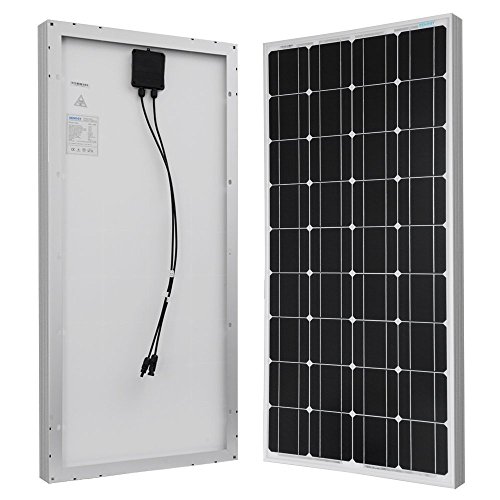





Hallo,my solar system is 2 kva inverter rate am using pwm rated 50amps 55v DC ,my solar panels are 270watts 4pc and my my battery bank is 24V 600AH my system is not giving me the right running hourshours,what could be issues
Not enough sunlight (irradiance), not enough solar panels (m2), consumption too high (high kWr), system not efficient, the list continues.
what about one 150W, 12V panel and another 40W 12V panel in parallel for a MPPT controller ? same voltage, but different current
You can connect panels in parallel of the same voltage. The output current will be the sum of the two (or more) panels
Great site! New to solar so I visit quite often!
preparing to participate on a 2 month off grid adventure in a month . Unable to mount anything so I am currently practicing a portable setup on the ground.
I have a 12v 75ah deep cycle battery , 20amp MPPT controller and 4 -50w panels. Oh and 25 ft of wire to the battery. My panels:
2 are 22.0v , 2.74a
2 are 22.7v, 2.84a
After studying your explanation of series vs parallel. I determined a parallel setup would be best. I purchased a 4-1 parallel connectors to achieve this.
Theoretically (if I was a good student) I should be receiving around 11amps. (2.74+2.74+2.84+2.84.) However, I am struggling to get 1.8 amps and unsure how to troubleshoot the issue. I have experimented with adjusting the the angle and regardless it only fluctuates a tenth or two. I know there is going to be some loss from the energy traveling through 25 ft which is why I opted for the MPPT over the PWM controller but I a bit stumped on a solution and thrusting myself in a mode of analysis paralysis hehe. Would you have any guidance on the setup? Thanks in advance!!
The battery load connected to the panels will dictate the output from the panels. If your batteries are nearly full of charge, then the demand through your MPPT will be reduced. Likewise if your batteries are nearly empty of charge your MPPT will expect more from the panels. Just because your panel has a peak power output of 100W does not mean it will supply 100W constantly no matter what the sun is doing. Connect some additional dummy load across the MPPT, such as lights, power resistors, heating elements, etc and see if the current increases. That will give you your answer.
I know it will never give peak output but I was a bit surprised at just how low the amps were. I have learned MPPT controllers use a smarter technology over the PWM and since my battery was only was only about 25% discharged your explanation makes complete sense.
So much more to learn! I will add some loads and monitor the power output. Cool Stuff 🙂
Appreciate your time!!
I have 2*200w and 1*250w 12 volts panels what would be the most efficient connection to charge 2*150Ahp battries .can this system run a 0.5HP submisible pump using a 1000W inverter
I am seeking micro panels.
The internet is full of companies selling solar panels including Amazon. It depends on what you mean by “micro panels”.
i have 4x12v ~8a pannels. Connected them in parallel. It should be 12x(8×4)= ~384W, but my max what i get from them is around 155w. Its seems like i getting around what 1 pannel rated to get. Checked voltage every single panel and its around 17-22v output and around 7-9a. So why they not producing what they should be on very sunny day, no clouds? I have 12v x2 storage deep cickle batteries (230AHx2). Not even those gets charged for the night use. The inverter is 1KW micro grid tie MPPT function inverter. Charge controler is 12V/24V Boost MPPT Wind Solar Hybrid Controller (yes i have wind turbine connected)
The amount of sunlight (irradiance), temperature and the connected electrical load all affect the output of a solar panel. Manufacturers specify the electrical wattage of their photovoltaic panels with an irradiance of 1,000 W/m2 at a temperature of 25 degs.C so unless you replicate these ideal conditions your panel will not produce the same wattage.
Also the electrical load connected to the panel will determine its operating point as P = I^2*R. If a battery is connected to the panel then the battery voltage will set the panels operating voltage between the battery being full discharged and fully charged. For battery charging a PV panels maximum power voltage needs to be higher than the battery terminal voltage, usually 14.5V for a 12-volt lead-acid battery.
The problem I see here is with your mppt controller. Did you notice the required specs of the mppt charger so as to create the required setup on your panels so that you get the most out of them. It could be you did not reach the required minimum threshold voltage for your mppt or that you have exceeded the maximum number of panel wattage you should connect. In any of the cases stated above you will get less power out of your panels.
got doubled amount of production just by changing to shorter and thicker cables for DC.
That’s true, shorter thicker cables means lower resistance, which reduces the I*R voltage drop along them for a given current, which means less wasted I2R power.
So if you had the 4-100watt premium kit and wired it Series of same characteristics,and one panel was shaded,none would work,correct?
How to connect 6nos 24 volt panels for 3kw inverter
What’s the input rating of your inverter, please read the manufacturers operating manual.
These options are great, but I’m missing how they are possible with certain charge controllers and 12 volts systems.
I have four 100 watt 18 Voc, 5.5 amp Ioc panels.
After reading multiple forums about series and parallel connections, I decided on best of both worlds… 2 series strings combined (paralleled) into a 20 amp CC.
This also worked physically as my space is limited … I have my 4 panels across my 5×7 trailer roof. A 2 x 2 layout would not fit given panel dimensions.
But that means it’s very difficult to wire them in parallel.
I’m also running s ‘unique’ battery combination/setup… I have 1 12 volt deep cycle FLA and 3 12 volt SLAs… the first is over the trailer tongue, the latter bank is under the frame.
So no 24 volt optionality.
I have the Renogy 20 amp Duo Charge Controller … each battery bank is wired floating seperately (pos & neg)… then I have a 1, 2, both (I will never use) and Off (4-way) switch into my 1000 watt inverter. I have 2 load panels (fuse boxes) one off each battery bank with common grounding.
So… I’m looking for options on CC (as Renogy says 240 watts is max on the 20 amp CC)… and apparently I can’t wire 4 18 volt 100 watt panels in series as that would be 72 volts.
Need help, suggestions, advice.
Why is it
Excess wire. The panels are all in portrait orientation, so all my junction boxes are in a row, but no space to tuck or hide away wires. The panel are surface mount, flexible so no frame or mounting brackets to hide wires.
I have actually scraped the 2 battery bank option, and upgraded to a 40 amp MPPT charge controller. So I now have four 35 amp-hour 12 volt batteries in parallel.
Unless the trailer is under/near a tree or obstruction it is highly unlikely I will ever get partial shading of the array.
All 4 panels are Ipmax – 5.5 Amp, Vpmax – 18 Volt, Isc – 6.1 Amp, VoC – 22 Volt
Any suggestions on best wiring… all parallel, all series, parallel – series?
With a 40amp mppt controller, I bet all is possible. As of the panels, you can wire them all in series to get 72V DC, and the Moot will adapt itself to the battery and inverter voltage. I assume the mppt controller at 40amp can take up to 80volts(kindly check with the specs)
Hello…iF I HAD 6 X 100 WATT 12 VOLT SOLAR PANELS…CAN THEY BE CONNECTED IN PARALLEL USING 4MM BLACK SOLAR CABLE INTO A 50 AMP CHARGE CONTROLLER THEN INTO ONE 125 AH LEISURE BATTERY… RUNNING A GIANDEL 3000 WATT INVERTER…MANY THANKS.
One 100W 12V panel could supply a maximum of 8 Amperes. 4mm^2 cable is rated at about 40 amperes. So 4mm^2 cable can be used as linking cables for your parallel connected panels. However, panel array to charge controller would potentialy be a maximum of 48 Amperes (6*8), so depending on length of cable run required to charge controller you may need 10 or 16mm^2 cables.
Great article and start to what the book has to offer!
I’ve just purchased 4 sunpower 305w 60v 5.58a solar panels, could you recommend the proper charge controller. At this moment I dont have and inverter or batteries, I am planning on also purchasing those items shortly.
I have 3KW inverter 48 Volt. how many 330W solar panels of 37 Volt will I use and how must I connect it to give me the 30 Amp that I need to charge the battery’s
My question is I have 5 100 watt panels 12 v rated at 3 amp each with 6 amp charge controller can I hook up in parallel each with separate charge controller to charge 2 6 v batteries in series
Yess you can connect the panels in parallel and the batteries in series to create a 12 volt system.
hello,
i have 36 panels of 300watts/75amps each and 30 batteries of 12v/200amps. what type of charge controller do i need to give 16Kva power and in what array please.
regards
lemi
Dear Admin,I am using 3 kw 48 volt solar ups which support 3000 watt panels,and as advised by the company i am using 12 solar panels of 250 watt 24 volt by pairing two solar panels each to make 48 volts ,My problem is that my mppt solar ups only shows max 30 amp at peek hours.do you thing 30 amp are sufficient to charge 4 12 volt 180 mah batteries or there is a problem in solar panels or wiring?please advice
Solar irradiance and ambient temperature affect a PV array’s voltage and current output. Charging current depends on the depth of charge of the batteries, so if the batteries only need 30 amps to charge then that is what your array will supply. We can not comment if you have a problem with your panels or wiring. Its your system you will know.
I have 20 327 watt panels at 60v and 6 amp rating. I am looking to purchase a controller Magnum 100 controller. It states optimum battery voltage is 48, Max input 190V. and 100amp rated. So could I series wire two arrays to 120vDC then parallel the two arrays so that I make a 120vdc system producing 60 watts. And then since my panels are 60 volt, still uses the 48v system on batteries instead of 60v wiring on batteries. I suppose this unit would not charge a 60 volt battery combination. Could you advise on this one? Thank you, Tex.
Two panels in series would give 120V, 6 amps per string. If you have 20 panels then you will have 10 strings giving a total array combination of 120V PV array voltage producing 60 Amps. If your controller input is rated at 190V, 100 amps max, then the proposed array is within its limits. The 48V relates to the output battery bank voltage.
Hello, I picked up a 100W 18V 5.5A panel and want to connect it with a 40W 17.1V 2.3A panel, I’m assuming it will be no more than 17.1V @ 7.8A when wired in parallel (under ideal conditions) ? Also was hoping to use the 30amp charge controller that came with the larger 100W panel, I will be using this setup on a travel trailer when off grid camping to keep batteries topped up.(2 12V 85ah deep cycle batteries wired in parallel) would this work and be equivalent to a 140W panel, ? Thank you,
Luke
It would not be equivalent to a 140W panel, no, but would be close. Connecting in parallel with blocking diodes would be the way forward.
Hi
I have 9 x 325w 48v canadian solar panels with a Victron 150/85 charge controller connected to 4 x 200ah AGM Batteries to a 48v 5000 Victron Multiplus the panels are connected 3 strings of 3 or would panels connected 2 in series be more efficient
A 9 panel array would still give you the same output power no matter how you connected them. The only difference is in total output voltage and current due to the various combinations. Check your controller manual for recommended V and I input values.
Hi,
I have 6 panels of 8.9Amp and 38.2V each making them in total 2KVA. I have currently joined them in parallel but often the amperes would go down to real low level such as 0 or 10 and the other times it give almost 40-50amps too. Now i was wondering if i need to do the connection right. My Inverter manual suggests Max PV array open circuit voltage of 102Vdc and PV Array MPPT voltage range of 30~80Vdc. It also illustrate an example of joining 2 sets of 30.1V panels in series and three in parallel.
Can i join my 2 sets in Series and 4 in parallel? i was wondering if that would even work.
The configuration of your array will depend on your inverter input requirements as detailed in your manual. The output from the array will depend on many different factors, such as the amount of irradiance, temperature and more importantly the connected load. Check your conditions and state of the load at both low and high amperage levels to understand your system better.
Hallo Admin,
I have connected 3 12V 100w panels in parallel to my solar inverter. Each panel current rating is 6.4A. The out put I am getting as about 15 V and and charge is varing from 1.1A to maximum 1.9A. It is supposed to charge at minimum of 10 A. By checking individuals panel the it is showing only 1.1 A charge. I am not able to understand the problem, Could you advice me.
Why should it charge at 10A
As per the parallel diagram given above it should be 6.4 * 3 = 19.2A. Based on sun ray intensity I expected about half of it. But I am getting very low. Could you advice me.
DV Reddy
I love this lecture on PV solar connection, is very comprehensive and educative.
I really appreciate. Please keep it up.
Thanks!
I have 2 panels wired in Parallel , I would like to check each one to confirm that they are functioning as they should. I tried covering one panel at a time and the voltage / amps does not change much . Should I disconnect one at a time to get a accurate reading from the uncovered panel or is there a better way?
Any assistance would be great
thanks Ron
You may not see much change as it is possible your panels have a built-in bypass diode for protection. The only way to check the operation of each panel is to disconnect and test them individual.
I have 2 x 100 watt panels, and 2 x 65 watt panels on a sailboat, and a Tracer 3210 MPPT controller. Should I link them in Parallel or series? or the 2 x 65 watt in Series, and the 2 x100 watt in parallel?
Again, the connection of your array will depend on the IV input power charcacteristics of your controller, inverter, or DC voltage requirements.
I have 16 Solar Panels containing 300watt in each panel while I want to have these panels with 5kv Inverter. Could you please guide that what combination of panels (like Series/Parallel) should I use?
That depends on the IV power rating of your inverter and the reason why you purchased 16, 300W panels.
hello admin, can I connect inverter to solar panel at the same time to light for charging the battery? Hope it will not cause outbreak?
Sir I have 4 solar panel of 350 watts can I use this to 24 volt system which contains 2 batteries of 12 of each volts and ups of 3kv can this system works?
Possibly, configure your panels and batteries to operate as a 24 volt system.
Can u please give me an istruction or diagram for different watts panel board…
Sir i have a question i have 300,,watts 43v panel and 250w 43v panel may solar charge controller is mppt-40A with 2 batteries 12v what connection we use.
As your panels have exactly the same Voc, connect them in parallel.
Hello, I have two separate mobile solar systems. Each system has 3 matching 50w/17v panels, a 165w controller, 4 29DC 12v batteries and 3000w rated PSW inverters. I’m wondering if occasionally I can parallel the two systems together into only one of the inverters when I dont need them to be in different locations? I really dont want to change the system in any other way if I dont have to. The battery bank will then be 8 batteries (4 each in parallel) and be charged thru two 165w controllers at the same time. Will this cause each controller to conflict and/or confuse each other somehow? Like when one controllers is charging the batteries at max, the other controller will see the voltage and shut off? Thank you
It depends on the type of chargers used. Parallel charging delivers increased amperage (amps x number of chargers) but it is advisable to use the same type of controller, MPPT and that the controllers are set with the same charging profile for voltage regulation. Also each controller’s Voltage Sense Terminal needs to be connected to the battery bank to ensure each controller is measuring the same battery bank voltage.
sir 4 panels 300 watt 2 panels 250 watt and 5 panels 150 watt and 3000 watt 48 volt ups how connect panels plz help.gaigram
I have an array of 30 247 Watt solar panels. One was destroyed by lightning. I have not been able to secure a replacement as everything today is higher wattage. Can I use a 250 watt or 325 watt replacement? Can I use a Poly system in the Mono system? Old one has 60 modules and replacement may be 72. Comments please. Thanks
The 250W panel would fit better into your existing system than the 325W panel. Yes you can mix mono and poly panels. Generally, monocrystalline solar panels perform slightly better than polycrystalline solar panels but the efficiency of one compared to the other is influenced greatly by installation and climate conditions. Monocrystalline panels are also more expensive due mainly to their higher production costs.
Respected Sir,
I have two solar panel, And the above method showing three panel. I have already connect two solar panel the above method can’t working. Please show me method.
Hello Thanks for the great info.
I have a question regarding a small solar array I want to setup.
I have 6 16w panels (20v) I want to hook them up in Parallel. They do not have any wires at the moment. Can I wire each panel so the positive goes to a positive bus bar and the negative goes to a negative bus bar then take a single lead from there to my charge controller? Vs having a bunch of wires connecting in a chain.
Yes, that is how you would normally wire a parallel array, but remember to size the bus-to-controller cables correctly to suit the maximum amperage and minimum voltage drop across the cable or your efficiency will decrease.
Thanks!
Hi,
I have 4 panels, 24v/250W each. I want to series connect them into 2 pairs, essentially then having 2-48V ‘panels’ that I will connect in parallel having a 48V system to feed my MPPT controller. Make sense?
Yes, sounds ok.
i have a 100w 18voltage solar panal and 50w 12voltage panal how to connect maximum solar power reciving system i need to help me
You can wire them together in Parallel, but will only end up with 150 Watt 12 volt., 12.5 Amp
So I’m new to solar power however I’m very interested in getting my home and 2 garages off the grid this would include ALL of my appliances and per tools etc … I’m not even sure where to start most of my power tools are 220 stove is 240 dryer is 230 and then the started 110 for lights appliances etc … what would I need to do to run solar into my breaker boxes? Do I need different solar arrays for 110, 220, 230 & 240 ?
This is a very open-ended question as the size of your solar array, storage batteries and/or inverters depends greatly on your homes energy consumption. Living off-grid will only work if you drastically reduce your consumption and change to low voltage appliancies that can be powered from a battery bank during night time use.
Hello Admin,
I have a 12V 200W Solar panel and a 12V 200Ah Battery. The system seem faulty as the battery is not going above 12.9Volts. Nevertheless it functioned only one day and went 12V off. What should I change or add ?.
Thanks.
John (Kenya)
Perhaps your solar panel is underrated as a 12 volt 200Ah battery would give fully charged 2400Whr (12*200). If you drain the battery to 50% charge (it could be more), then the amount of solar energy needed to fully recharge the battery back to 100% is 2400Whr*50% = 1200Whr. Assume 6 hours of full sun during the day, thus you would need a 1200Whr/6Hr = 200W Solar Panel which is what you have.
But here it is assumed you only discharge the battery to 50%, you have 6 hours per day of full sun, no system losses (which could be upto 30-40%) and no charge controller. Worst case with 10% charge and only 3 hours per day of full sun, would require a 720 watt panel minimum.
i have a system composed of 950w solar painel and a 900ah battery bank.how long can the system last?and how do i connect the panels 150w +8(100w)panel and a pwm 60amps solar controller?
Can you Help?
a) “how long can the system last?” – It depends on the load consumption and depth of discharge
b) “how do i connect the panels” – It depends on the input characteristics of the controller
c) “Can you Help?” – No.
i want know when u are using solar panel to run compressor with centrifigucal pump in well.how many needed
Hi,
thanks for this informative page.
I have 6 200w 12v panels; wanting to know the best way to hook them up to an Outback Flexmax 80 controller rated to 1000w 12v max, 2000w 24v max or 4000w 48v max. Do I just do 5 panels in parallel = 1000w 12v, or 2 pairs of 3 12v in series then hooked together in parallel, or 4 panels hooked in series with the 2 additional panels in parallel?
This will all be hooked up to 8 x 6v 520ah agm’s in a 12v configuration. Thanks for your help; any advice or suggestions welcome.
Keep up the good work 🙂
Hey, I want my solar panel to deliver 5kW if I use it for suppose 6 hours. So basically, I want my solar panel to give 1kW or 1.5kW in one hour and I want my voltage delivery to be around 200. But I am not able to do so.If I increase the series strings to get more voltage, then power increases which I dont want and if I keep the combination of series low then I dont get the required voltage.
We have two 5 KW systems (Off Grid, 5 years old) in separate locations. We plan to move them to a single location and convert them in to a single 10 KW On Grid system. One thought is to go for a 20 KW Inverter so that any future upgrades only requires addition of solar panels. What are the risks involved in the upgrade to 20KW?
You work it out, location not suitable, not enough solar irradience, cabling too small, equipment under rated, investment cost high, etc, etc.
Hi I have 4 300 watt solar panels what size charge controller will I need
4 panels of 300W each would give a maximum output of 1.2kW at full sun and 100% efficiency.
Great explanation!
I recently installed 1x100wx12vx5a + 2x235Wx12v8a and a 40amp MPPT EPEVER tracker. I thought I had wired them in parallel (+ to + and – to -) but my charge controller monitor is showing 34.1v and 10.8amp. My battery bank is 3 24 series 79ahp hour AGM deep cycles connected (+ to + and – to -). Because now I think the panels are in series should my battery bank also be connected + to -??
Hi .I presently have a system with 3 – 180w 12/24v (5.05amp@ 12v) solar panels going to a 45 amp Tracer regulator .I think it is in series because it shows 42 volts on the tracer monitor . With 3M of AWG 6 gauge cable , ( 56 amp ) . I ‘m looking at extending 3M and install a 200w 12/24 (5.35amp@ 12v) panel and keep it in series. Would that be the thing to do or is there a reason to change the system to parallel ? I believe I am at the limit with the length of wiring (WH 3062) @50 amps and the 45 Amp Tracer about 43 amps ? Hope you can help me.
Connecting panels in series will increase the voltage and not the current, although there may be a small adjustment in the current value if your panels are mismatched. As solar panels are a DC system, cabling is important as it has a resistive value and therefore as current passes through it creates an I^2*R voltage drop across its length. The result is for long cable runs the voltage at the load could be a lot lower than the voltage generated at the source. However in your case of 3 metres, the voltage drop would be minimal, and the cable would be more than capable of carrying the amperage at the increased series voltage.
If we have Voc=500 volts, I=13 amp. What would me maximum wattage that could be connected with solar panel if: 100 watt, Impp=5.7 amp Vmpp=18volts 36 cells
i have 155w panel with 4.48a 35v i want to add 70w 4.0a 17v together, please should i do it in series or parallel connection
series
i connected in series the Voltaga increases and the amp reduced, while i connected in parallel the voltage reduced and the amp increases, which one should i choose.
series
Neither way is good. Either replace one panel or run each panel to a separate controller.
That was not his question, perhaps he has no funds to replace panels or buy additional equipment. The voltage mismatch is too great for a parallel connection but in series with an increased voltage (35v + 17v) the current is less mismatched, 4.48A to 4.0A. Hence a series connection would make more sense for his existing panels.
Good day,please help me,I have a 1.5kv inverter with a 40 amp charge controller and four 250 Watt solar panels ,am I to connect the panels in parallel or series the inverter is 24v.thank you.
It depends on the rating of your panels
can i use 155w panel (4.4a, 35v) for 10amp charger controller
I would like to know how it is best to hook up batteries for solar panels for maximum output. I can run 3 fans all night at our cottage, but if I do I can’t use the coffee maker in the morning. I have 3 solar panels, inverter and 2 deep cell batteries in parallel. Solar panels are also in parallel. And it is a 3000 watt inverter. Do I need more batteries, hooked in series???
If your existing configuration is not capable of powering the load you require, then yes you may need more battery capacity.
Thank you for an interesting conversation. My question:
I have a 15kW rated grid-tied 3 phase inverter and can connect 3 strings of 290W PV modules limited to 750Vdc per string.
Connecting my PV strings in series will provide Isc =9.8A (module datasheet) per string.
The inverter AC output is balanced 23A per phase.
I have a 20A EV charger and want to make sure that the actual inverter AC output current will be sufficient for charging using the PV system.
Does this mean that I better arranging my solar arrays in 2 parallel strings in order to achieve 19.6A current input on the DC side?
Does higher current on the DC side equal higher current on the AC output?
Thanks in advance.
Power is voltage times amperes (V*I) so higher current on the DC side will result in a proportionally equal change on the AC output up to the max rating of the inverter, both DC and AC sides. Your electric vehicle charger will draw the required current from the inverter at an amount determined by the charge condition of the batteries. If your vehicle requires more charge, then you could try reconfiguring your connections. Your vehicle manufacturer and solar seller can advise better on this.
Great reply, Thanks!
The solar seller is intending to make the connection I describe here.
3 solar arrays (Sth= 10 panels, East = 12 panels and West = 20 panels)
The inverter has 3 string solar inputs.
Sting 1 = 10x290W modules in series (2.9kW array, Voc=393V, Isc =9.8A)
String 2 = 12x290W modules in series (3.48kW array, Voc=471.6V, Isc= 9.8A)
String 3+4 = each string 10x290W in series, connected in parallel (5.8kW, Voc=471.6V, Isc=19.6A)
I wonder what will be the3 phase inverter’s AC current output (after losses). I know that it will have an equal output for each phase but not sure if it will be an average of the input currents or the lower of the lot…